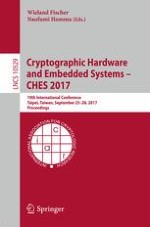2017 | OriginalPaper | Buchkapitel
Improved Blind Side-Channel Analysis by Exploitation of Joint Distributions of Leakages
verfasst von : Christophe Clavier, Léo Reynaud
Erschienen in: Cryptographic Hardware and Embedded Systems – CHES 2017
Aktivieren Sie unsere intelligente Suche, um passende Fachinhalte oder Patente zu finden.
Wählen Sie Textabschnitte aus um mit Künstlicher Intelligenz passenden Patente zu finden. powered by
Markieren Sie Textabschnitte, um KI-gestützt weitere passende Inhalte zu finden. powered by
